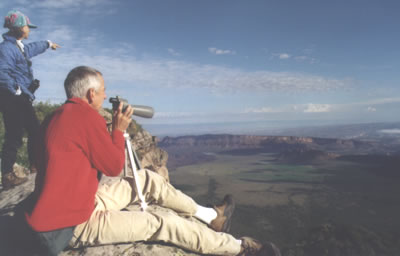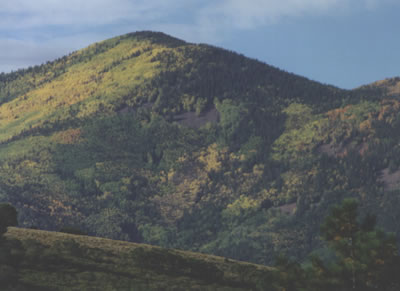Light
winds from the northeast caress the cliff face below us before
they pass southward towards the mountain peaks. Several of
us sit near the edge of Bull Canyon - a small slice in the
northeast edge of the La Sal Mountains. Better known for
the nearby dinosaur tracks, this rim is our vantagepoint
to watch the migration of southbound birds of prey.
Sharp-shinned and Cooper’s hawks, both relatives in the Accipiter
Family of raptors, seem to be the most common hawks that pass by this
site. At times they are difficult to distinguish from each other due
to plumage similarities and their close size overlap. The sexes of each
species are dimorphic, meaning that females are larger than males. This
adds a degree of confusion into the in-flight identification. Whereas
a female sharp-shinned hawk is almost as large as a male Cooper’s
hawk, their partners form the extreme ends of the scale. The smaller
male sharpies seem to rock in flight when buffeted by even the slightest
of breezes, while the female Coop flies as steady as a Boeing jet.
In the mix of adults and juveniles it is interesting to note the relatively
longer wing and tail feathers on the juveniles. These first-year feathers
will hopefully help with the bird’s maneuvering, as they must now
hunt on their own. Short on experience, this species may suffer a high
mortality percentage during their first winter. Starvation and disease
take their toll, as well as illegal shooting.
Joining the accipiters are small falcons formerly known as sparrowhawks
and today referred to as American kestrels. Somewhat similar in size,
females are distinguished by their barred brick-red backs and tails,
while the males have rusty brown backs and bluish wings. At a distance
they may be mistaken for a sharp-shinned hawk, but their sickle-shaped
wings, which are drawn backwards to a distinct point, readily distinguish
them from the sharpies.
During the breeding season, sharpies nest in woodlands while kestrels
are birds of open areas, often usurping an abandoned woodpecker’s
or screech owl’s home for their own. They take to nest boxes, artificial
homes that may be attached to interstate signs or residential trees,
where natural structures do not exist. These falcons are not built for
zooming through woods or chasing prey down through thickets like the
sharp-shins.
Often seen hovering above a grassy field, kestrels search the field below
for mice, grasshoppers or even small birds. During migration they stop
to hunt, unlike their close relatives the merlins that can consume dragonflies
on the run.
Interrupting the quiet migration moments are the raucous ravens and local
jays, scrub and Stellar’s, parading between oak groves and their
caches. As the birds fly by, sometimes at eye level, it is easy to see
their crops bulging with their baggage of nuts. These birds horde acorns
for winter consumption, and judging by the constant traffic, perhaps
this winter will be a long one.
The members of this bird watch ponder the final location of each raptor
that passes our view. Perhaps that kestrel will winter in Arizona, while
the Cooper’s hawk may travel as far south as Costa Rica. We catch
a peregrine falcon cruising southward, which interrupts our conversation
and creates a stir among the birders and birds. The birders get excited
because this is the first, and only, large falcon of the day. The flow
of jays suddenly ceases as this aerial predator parts the local bird
traffic like Moses at the Red Sea.
Peregrine is from the Latin word “peregrinus” which means “wanderer.” True
to their description, these birds may end up hundreds of miles from their
natal areas or cross vast stretches of ocean and end up overseas. One
such bird, banded in the Glen Canyon National Recreation Area, ended
up in Japan one winter.
As morning turns to afternoon, the flow of birds decreases to almost
zero. Red-tailed hawks and a northern goshawk round out our species list.
Several birders head back down the hill, returning to Moab and other
obligations. A few of us remain; the drive to leave means we might miss
an unusual species or some spectacular display.
This site doesn’t rank high in hawk migration circles. Nothing
like the Goshute Mountains, west of Salt Lake City, where a thousand
birds might pass the observation station on a good September day. It
pales in comparison to the Isthmus of Panama, the umbilical cord between
Central and South America. There a million raptors a day might funnel
between those two areas. Whereas we might record thirty or forty individuals
on a good day here above Bull Canyon, it is the ambiance that draws us.
Perched on this rocky rim we have a front row seat to one of the greatest
natural phenomenons of the avian world – the September Sojourn.
|
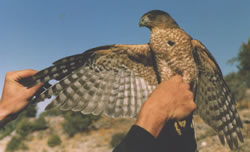
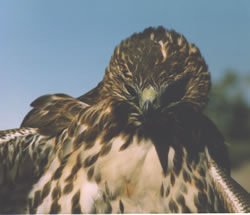
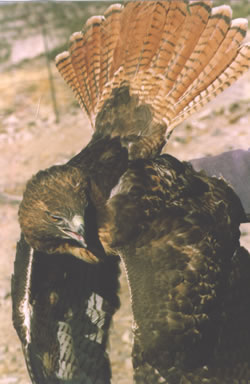
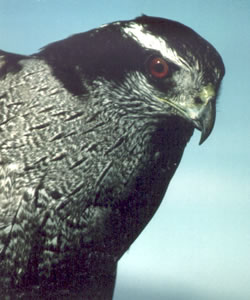
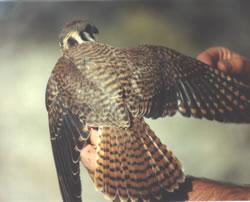
|






